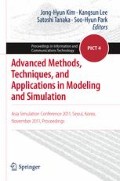Abstract
In this study, we introduce the method of reconstructing more natural synthetic voice by using radial basis function network (RBF) that is one of neural network that is suitable for function approximation problems and following and synthesizing vocal fluctuations. In the synthetic simulation of RBF, we have set the Gaussian function based on parameters and tried to reconstruct the vocal fluctuations. With respect to parameter estimation, we have adopted to nonlinear least-squares method for making much account of the nonlinearity of human voice. When we have reproduced the synthesized speech, we have tried to reconstruct the nonlinear fluctuations of amplitude by adding normal random number. We have made a comparison the real voice and the synthetic voice obtained from simulation. As a consequence, we have found that it was possible to synthesize the vocal fluctuations for a short time.
Access this chapter
Tax calculation will be finalised at checkout
Purchases are for personal use only
Preview
Unable to display preview. Download preview PDF.
References
Tokuda, K.: Fundamentals of Speech Synthesis Based on HMM. IEICE 100(392), SP2000-74, 43–50 (2000)
Kitani, M., Hara, T., Sawada, H.: Autonomous Voice Acquisition of a Talking Robot Based on Topological Structure Learning by Applying Dual-SOM. Transactions of the Japan Society of Mechanical Engineers Series C 77(775), 1062–1070 (2011)
Kanda, H., Ogata, T., Takahashi, T., Komatani, K., Okuno, H.: Simulation of Babbling and Vowel Acquisition based on Vocal Imitation Model using Recurrent Neural Network. In: IPS 2009, March 10, pp. 2-133–2-134 (2009)
Maeda, E., Arai, T., Saika, N.: Study of mechanical models of the human vocal tract having nasal cavity. IEICE 103(219), 1–5 (2003)
Minematsu, N., Nishimura, T., Sakuraba, K.: Consideration on infants’ speech mimicking and their language acquisition based on the structural representation of speech
Golder, E.R., Settle, J.G.: The Box-Muller Method for Generating Pseudo-Random Normal Deviates. Journal of the Royal Statistical Society. Series C, Page 19 of 12–20 (1976)
Dai, S., Hirohku, T., Toyota, N.: The Lyapunov Spectrum and the chaotic property in speech sounds. IEICE Technical Report. Speech 99(576), 37–43 (2000)
Ogawa, S., Ikeguchi, T., Matozaki, T., Aihara, K.: Time Series Analysis using Radial Basis Function Networks. IEICE Technical Report. Neurocomputing 95(505), 29–36 (1996)
Suzuki, T., Nakagawa, M.: Fluctuashion of the vocal sound and its chaotic and fractal analyses. IEICE Technical Report. Nonliniea Problems 104(334) (2004)
Koga, H., Nakagawa, K.: Chaotic Properties in Vocal Sound and Synthesis Model. IEICE Technical Report, NLP99-120 (November 1990)
Wang, X., Niu, Y.: Adaptove synchronization of chaotic systems with nonlinearity inputs
Hartley, H.O.: The Modified Gauss-Newton Method for the Fitting of Non-Linear Regression Functions by Least Squares. American Statistical Association and American Society for Quality 3(2), 269–280 (1961)
Watanabe, T.: Consideration of Prediction Accuracy of Chaos Time Series Prediction by RBFN. The Research Reports of Oyama Technical College 39, 107–111 (2007)
Naniwa, Y., Kondo, T., Kamiyama, K., Kamata, H.: The exact reproduction in the voice signal of radial basis function network. IEICE Technical Report 110(387), 199–204 (2011)
Author information
Authors and Affiliations
Editor information
Editors and Affiliations
Rights and permissions
Copyright information
© 2012 Springer Tokyo
About this paper
Cite this paper
Naniwa, Y., Kondo, T., Kamiyama, K., Kamata, H. (2012). Study on the Artificial Synthesis of Human Voice Using Radial Basis Function Networks. In: Kim, JH., Lee, K., Tanaka, S., Park, SH. (eds) Advanced Methods, Techniques, and Applications in Modeling and Simulation. Proceedings in Information and Communications Technology, vol 4. Springer, Tokyo. https://doi.org/10.1007/978-4-431-54216-2_32
Download citation
DOI: https://doi.org/10.1007/978-4-431-54216-2_32
Publisher Name: Springer, Tokyo
Print ISBN: 978-4-431-54215-5
Online ISBN: 978-4-431-54216-2
eBook Packages: Computer ScienceComputer Science (R0)

